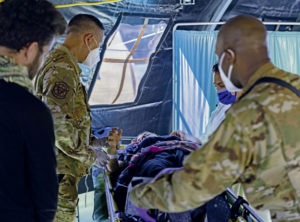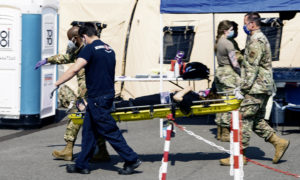
The birth of a child during an evacuation operation at the height of Operation Allies Refuge on the ramp of a C-17 Globemaster III aircraft signaled a reminder of hope during a time of upheaval and uncertainty.
An Afghan woman who was approximately 34-weeks pregnant boarded a military aircraft, call sign Reach 828, from Al Udeid Air Base in Qatar, Aug. 21, 2021. During the six-hour flight to Ramstein, the woman went into labor and began experiencing complications due to low blood pressure, according to the aircrew and medical team onboard. The aircraft commander descended to increase air pressure in the aircraft — a decision that helped stabilize the mother’s condition and manage labor.
Upon landing, emergency responders from the 86th Civil Engineer Group fire department, 86th Medical Group, and Landstuhl Regional Medical Center rapidly arrived on scene. Due to cultural sensitivities, a team of female service members boarded and attended the mother as she was in delivery. Female Afghan passengers who were assisting the mother through labor held tarps to afford privacy.
“When we got on board, we realized she was still in labor and had a good team of other Afghan women supporting her throughout her contractions,” said U.S. Army Capt. Erin Brymer, Landstuhl Regional Medical Center obstetrics and gynecology clinic registered nurse.
With the baby crowning, the medical team recognized time was of the essence, regardless of the unique setting and limited resources.
“In labor and delivery, we deal with emergencies every day, so it’s always in the back of our heads what the worst possible scenario is and the best possible scenario,” Brymer said.
With only the supplies at hand and facing a field birth, the team quickly accessed the conditions and identified necessary equipment for the baby’s delivery.
“We had a kangaroo board for all of our emergency baby resuscitation equipment and I also had a backpack with very minimal delivery supplies with towels and cord clamp scissors, which was all we really needed,” Brymer exclaimed.
The mother, with the assistance of the joint-service medical team, delivered the child in the cargo bay of the aircraft.
“This was a surreal experience,” Brymer said. “This is my first delivery in the wild.”
Medical personnel who aided in the delivery are as follows:
- U.S. Air Force Maj. Caitlin Hammond, 86th MDG pediatrics doctor
- U.S. Air Force Maj. Kristi Blouin, LRMC neonatal intensive care unit nurse
- U.S. Air Force Staff Sgt. Lamaar Melvin, 86th MDG medical technician
- U.S. Air Force Staff Sgt. Allison Pascual, 86th Healthcare Operations Squadron Emergency Response Services Technician
- U.S. Air Force Airman 1st Class Neomy Martinez, 86th HCOS Emergency Response Services Technician
- U.S. Air Force Airman 1st Class Peighton Walker, 86th HCOS Emergency Response Services Technician
Once the baby arrived and umbilical cord cut, Pascual carried her to the ambulance awaiting outside the tail end of the C-17.
“The baby came out screaming!” Pascual said. “She was a beautiful, healthy baby girl and she reminded me why we are here conducting our mission: to help the evacuees see the light at the end of the tunnel.”

After the delivery, the mother and child were safely settled into the back of the ambulance, secured and monitored, then transported to LRMC. While the healthy mother and daughter recover, the experience has left a lasting impression on many U.S. service members participating in this humanitarian airlift effort.
“I think I am shocked about the pure number of pregnant women that are here,” Brymer said.
However, given the chaos and immense stress that has been placed on the evacuees, births and other medical issues have not been unexpected even if the numbers are far greater than anticipated.
“When you think about where they’re originating from … and then the transition to get from place to place; it takes a mental toll, a physical toll,” said U.S. Air Force Col. Adrienne Williams, 521st Air Mobility Operations Wing commander.
While aeromedical evacuation crews have been dealing with various medical emergencies during Afghanistan evacuation flights, the entirety of the Kaiserslautern Military Community have converged to create a safe space capable of temporarily housing a large number of vulnerable Afghans and other evacuees from Afghanistan as they transit to more permanent resettlement locations.
“Ramstein personnel are working tirelessly to ensure the evacuees have a safe, secure place to rest,” said Brig. Gen. Josh Olson, 86th Airlift Wing commander. “I am incredibly proud of our team’s ability to adapt and mobilize this herculean effort at a moment’s notice.”
As the U.S. military continues to airlift evacuees to safety, moments like this signal the worth of the historic undertaking at hand: the gift of life.
Often referred to as Baby Reach 828, this infant girl reminds Team Ramstein and the global community of the importance of this operation.
“After the long days and hard work, this keeps it in perspective,” Olson said. “We are helping bring people to safety and hope for new lives.”


